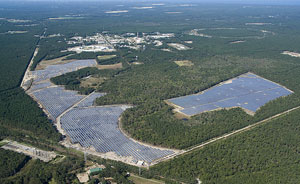It looks like New York could be following in California’s gigantic footsteps on solar after hearing Governor Cuomo’s State of the State address this month.
In addition to laying out a strong, prescient plan to help NY State dramatically increase its resilence to the changing climate, Cuomo’s promises on clean energy echo those that California Governor Schwarzenegger put forward in 2004.
That’s when Schwarzenegger made a long-term commitment to solar, targeting 3 gigwatts in in 10 years – Exactly where California is today.
NY Sun Initiative
Cuomo affirmed his long term commitment to the successful NY-Sun Initiative (which installed 300 MW in two years) by expanding its goal to the same as California’s – 3 GW in 10 years. He too set aside $1 billion to do that, in NY’s case by by 2023. That’s enough to power 465,000 homes in the state.
At the time, Schwarzenegger’s plan was considered revolutionary because for the first time, a state was making a long term, 10-year commitment, not just a single year budget. The California Solar Initiative (CSI) has provided the industry the certainty and stability to create a stable solar market. The NY Sun program does the same thing.
And just as CSI’s goal is to establish a self-sufficient PV industry in 10 years, New York is aiming at “the sustainable development of a robust PV industry.” Following California’s model, NY will pull back on incentives as demand grows, rather than cutting them each year. The plan targets key regions of the state to host projects of all sizes. It has megawatt block goals to make sure it reaches 3 GW by 2023.
NY Sun also has a goal of continuing to bring solar prices down and is succeeding at that. It has created a uniform permitting process for municipalities that cuts about $1000 for a residential system, for example. NYC’s Solar Map is being expanded state-wide, turning it into a one-stop-shop for solar: residents will be able to calculate their home’s solar potential, payback period and find all local, state and federal incentives.
Also like California, New York will consolidate disparate programs among NYSERDA, the utility PSEG Long Island, NY State Department of Public Service and New York Power Authority (NYPA).
And like California, NY has strong policies in place that support further deployment: net-metering up to 2 megawatts in size; third-party solar power purchase agreements; Property Assessed Clean Energy (PACE); and state tax credits up to $5,000 for residential solar systems.
Finally, as in California, NY has high electricity prices, which also favors solar build-out. NY ranks #2 for the highest commercial electric prices in the country, and #3 for residential electric prices, according to the U.S Energy Information Administration.
Long Island’s biggest solar system in Brookhaven, thanks to its Feed-in tariff:

NY Goes Even Further
Cuomo is going even further, establishing the nation’s first Green Bank, which will support solar PV and other renewable energy financing.
Another unique idea is "K-Solar", which would turn NY’s 5,000 schools into solar demonstration hubs to encourage entire communities to adopt solar. Community Solar NY will offer incentives, financing and technical assistance to schools for this purpose, with the goal of bringing down costs by expanding the customer base.
To make sure communities can keep the power on during future storms, Cuomo is launching a $40 million NY Prize competition to jump start at least 10 microgrids across the state. During emergencies, they would disconnect from the grid, maintaining stable power for crucial operations like hospitals, police, fire and gas stations. Solar will be an integral part of that.
In another crucial change, NY’s Public Service Commission announced it has begun to transform how utilities are regulated by emphasizing core policy outcomes. "We can no longer afford to think of energy efficiency and clean energy resources a peripheral elements of the electric system. Rather, the time has come to manage the capabilities of new customer-based technologies as a core, clean source of value to customers and the electric grid," says Audrey Zibelman, Commission Chair. It is restructuring energy efficiency programs from "top to bottom" encouraging demand management technologies, storage and distributed energy.
Renewable Heat
The heating side of the equation – Renewable Heat NY – will be more controversial. It’s goal is to make “a long-term commitment that helps the high-efficiency and low-emission biomass heating industry reach scale.” The idea is to use local sources of wood (from the state’s abundant forests) to deliver biomass heating that’s cheaper than oil.
The state will work with landowners on sustainable harvesting projects, initially delivering biomass heat to large anchor customers.
A competitive grant program will incentivize clusters of communities to build shared biomass heating systems. But whether people will support forest culling to produce heat has yet to be seen. “78 cents of every dollar spent on heating oil leaves the state; with biomass heating, fuel dollars remain in the state, recirculating in local and regional economies," says Charlie Niebling, president of the New York Biomass Energy Association.
Where is wind energy in all this? That will expand too, but since siting wind farms is much more challenging, the focus is on the solar, says State Senator Maziarz, who serves as energy chair.
NY State’s goal is to get 30% of its energy from renewable energy by 2015. Over the past year, NY moved from #12 to #10 for installed solar among the states. There are 400 solar businesses in the state employing at least 3300 people.
NY Sun website:

